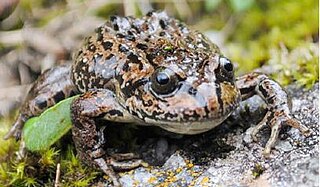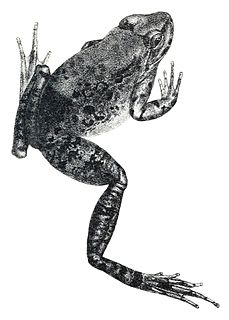Amolops viridimaculatus, also known as green-spotted torrent frog, Dahaoping sucker frog, and Dahaoping cascade frog, is a species of frog found in Yunnan, China, northern Vietnam, northern Myanmar, and Nagaland, Northeast India; it is also expected to occur in northern Laos.
The Shaping horned toad is a species of frog in the family Megophryidae. It is endemic to China and known only from Sichuan and Yunnan provinces. Its natural habitats are subtropical or tropical moist montane forests, subtropical or tropical high-altitude shrubland, and rivers. It is threatened by habitat loss.
Limnonectes liui is a species of frog in the family Dicroglossidae. It is found in Yunnan, China, but it likely occurs also in nearby Laos and Myanmar. The taxonomic placement of this species has been much debated and varies between sources.
Amolops loloensis is a species of frog in the family Ranidae that is found in southern and western Sichuan and one locality in north-central Yunnan, China. Its natural habitats are small mountain streams in forests and grasslands. It is threatened by infrastructure development for human settlement, potentially also by water pollution from the mining industry. T

The Doichang frog is a species of frog in the family Dicroglossidae. It is only known from its type locality, Doi Chang, mountain north of Chiang Mai (Thailand), Fansipan mountain in northern Vietnam, and Huanglianshan National Nature Reserve in Yunnan, China.
Nanorana quadranus is a species of frog in the family Dicroglossidae. It is endemic to central China. Its natural habitats are temperate forest and shrubland, with breeding taking place in small rivers. It is a common species believed to be declining. It is threatened by collection for food and also habitat loss.

Nanorana pleskei is a species of frog in the family Dicroglossidae. Until recently it has been only known from southwestern/central western China from elevations between 3,300–4,500 m (10,800–14,800 ft), but there is now one record also from Bhutan. Notice, however, that earlier records outside China have turned out to be misidentifications.
Nanorana ventripunctata is a species of frog in the family Dicroglossidae. It is endemic to northwestern Yunnan, China. It inhabits lakes, pools and ponds in alpine areas, occurring near streams and rivers in open, high-elevation habitats. It breeds in still-water pools and ponds.
Nanorana arnoldi is a large species of frog in the family Dicroglossidae. It is found in southwestern China, northern Myanmar, eastern Nepal, and adjacent northeastern India. Its natural habitats are subtropical or tropical moist montane forest, rivers, and freshwater springs. It is primarily threatened by collection for consumption, but also by habitat loss.

Nanorana blanfordii is a species of frog in the family Dicroglossidae. It is found in northeastern India, southern Tibet (China), and eastern Nepal, and likely in the adjacent western Bhutan. The specific name blanfordii honours William Thomas Blandford, a British geologist and zoologist.

Nanorana conaensis is a species of frog in the family Dicroglossidae. Its name refers to its type locality, Mama in Cona County in Tibet. Note that while large parts of Cona County are located within Arunachal Pradesh in the area that is controlled by India but claimed by China, Mama is on the Tibetan side of the border. It has recently been reported also from Bhutan. Its natural habitats are subtropical moist montane forest, high-altitude shrubland, and rivers.

Nanorana feae is a species of frog in the family Dicroglossidae. It is found in Yunnan, China, and the Kachin Hills in Myanmar. The specific name feae honors Leonardo Fea, an Italian explorer, zoologist, and naturalist. This little-known species probably inhabits hill streams in forested areas.

Nanorana liebigii, also known as Sikkim paa frog, Liebig's paa frog, Liebig's frog, and spiny-armed frog, is a species of frog in the family Dicroglossidae. It is found in the Himalayas, specifically in Bhutan, southern Tibet (China), northern India, and Nepal. The specific name liebigii honours a certain "Dr von Liebig Jr.", likely referring to Justus von Liebig, German botanist and chemist.
Nanorana maculosa is a species of frog in the family Dicroglossidae. It is endemic to central Yunnan, China, where it occurs in Jingdong County and Shuangbai County. This rare frog inhabits forest streams. It is threatened primarily by collection for human consumption. It is currently protected by the Ailaoshan and Wuliangshan National Nature Reserves.
Nanorana medogensis is a species of frog in the family Dicroglossidae. It is endemic to Tibet, China, and only known from near its type locality in Mêdog County in southeastern Tibet, near the Indian border. It lives in forested streams, and is sometimes also found at the edges of pools and ponds.
Nanorana polunini is a species of frog in the family Dicroglossidae. It is found in Nyalam County in southern Tibet (China), Nepal, and possibly Kashmir (India). It is a common species in Nepal but rare in China. It lives in stream habitats in montane forest.
Nanorana yunnanensis, commonly known as Yunnan paa frog, Yunnan spiny frog, Bourret's paa frog or Bourret's frog, is a species of frog in the family Dicroglossidae. It is found in southwestern China, Vietnam, Myanmar, northern Thailand, and likely in the intervening Laos. Its natural habitats are small and large streams in montane forests, scrub vegetation and grasslands, and it has also been found in ditches. It is threatened primarily by collection for human consumption, but also by habitat loss caused by agricultural development and infrastructure development.
Odorrana andersonii is a species of frog in the family Ranidae that is found in northeastern India, Upper Myanmar, southwestern China, northern Thailand, Laos, and Vietnam; records from Laos and Vietnam may refer to another species. They are found in low tree branches and on rocks along shaded rocky streams and large rivers with boulders, in evergreen forests and agricultural areas. Breeds takes place in streams.
Odorrana jingdongensis is a species of frogs in the family Ranidae. It is known from southern China and northern Vietnam, though it quite likely also occurs in the adjacent areas in Laos and in Myanmar. Its name refers to its type locality, Jingdong Yi Autonomous County in Yunnan. Common name Jingdong frog has been coined for it.
Raorchestes menglaensis is a species of frog in the family Rhacophoridae. Only known from its type locality, Zhishihe in Mengla County, it is endemic to Yunnan, China, although it is expected to occur more widely, including adjacent Laos.






